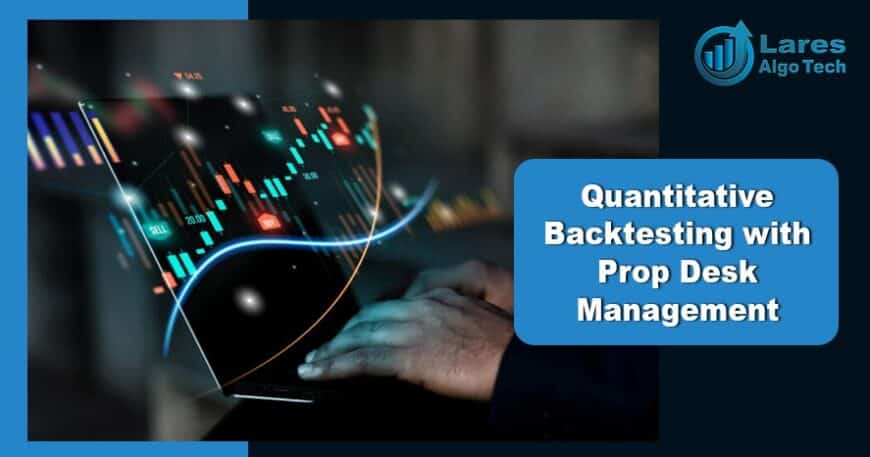Imagine you are a prop trader who wants to test your trading strategy before implementing it. You have a brilliant idea that involves using some advanced mathematical models and algorithms to exploit market inefficiencies and achieve your targets. In this blog, You will explore quantitative backtesting with prop desk management company But how do you know if your idea works in reality? How do you measure its performance, risk, and robustness? How do you optimize its parameters and avoid overfitting? This is where quantitative backtesting comes in.
What is Quantitative Backtesting?
Quantitative backtesting is a technique used to test the performance of a trading strategy or a model using historical data. It involves applying predefined rules and parameters to past price data. This will simulate how the strategy or the model would have performed in the past. The Quantitative backtesting with prop desk is a powerful tool that allows traders and investors to test their hypotheses, and validate their assumptions. These hypotheses and assumption can impact their decisions before risking real money in the live markets.
Quantitative backtesting can provide valuable insights into the risk, and robustness of a trading strategy or a model. It can also help to identify the strengths and weaknesses of the strategy or the model and to make improvements or adjustments based on the results.
How is quantitative backtesting with prop desk Related?
Prop desk management and quantitative backtesting are closely related because they both involve using data, analysis, and technology to trade in the financial markets. This prop desk management company often relies on quantitative backtesting with prop desk to develop, test, and refine its trading strategies and models. Quantitative backtesting can help prop desk management achieve their targets, lower risks, and better performance.
However, prop desk management and quantitative backtesting are not the same thing. It is a type of trading activity, while quantitative backtesting is a type of testing technique. It can use quantitative backtesting, but it can also use other methods, such as fundamental analysis, technical analysis, or intuition. Quantitative backtesting can be used for prop desk management, but it can also be used for other purposes, such as academic research, portfolio management, or risk management.
Why are prop desk management and quantitative backtesting Important?
They both are important because they can help them achieve better results in the financial markets. Prop desk management can offer more flexibility and more opportunities than other types of trading. Quantitative backtesting can offer accuracy, objectivity, and efficiency than other types of testing.
They both are also important for the financial markets because they can contribute to the liquidity, efficiency, and innovation of the markets. Prop desk management can provide liquidity by buying and selling various assets. It can enhance efficiency by exploiting market inefficiencies and anomalies. Quantitative backtesting can foster innovation by creating new strategies and models and can improve the quality and reliability of the existing ones.
How to Perform Quantitative Backtesting with a Prop Desk Management Company in India?
If you want to perform quantitative backtesting with a prop desk management company in India, you will need to follow some steps. Here are some of them:
- Find a prop desk management company that suits your needs and goals. There are many prop desk management companies in India. You will need to research their offerings, reputation, and requirements, and choose the one that matches your profile, preferences, and expectations.
- Learn the basics of quantitative backtesting. You will need to understand the concepts, principles, and methods of quantitative backtesting. It includes data sources, data quality, data processing, strategy design, and strategy testing. You can learn from various sources, such as books, courses, blogs, or podcasts.
- Choose a software tool or a platform for quantitative backtesting. You will need to select a software tool or a platform that can help you perform quantitative backtesting efficiently and effectively. You will need to consider factors such as functionality, usability, compatibility, scalability, and cost.
- Develop and test your trading strategy or model. You will need to create and code your trading strategy or model, using the rules and parameters that you have defined. You will also need to test your strategy or model, using the historical data that you have collected and processed. You will need to run multiple simulations, using different periods, data sets, and assumptions, to evaluate the performance of your strategy or model.
- Analyze and improve your trading strategy or model. Constant adjustments or modifications to your strategy or model are needed. This would be done on the feedback and insights that you have gained from your quantitative backtesting.
How Lares Can Help You with Quantitative Backtesting?
Fortunately, there is a solution that can make your life easier and your backtesting more efficient and reliable. It is called Lares, an automated trading system that offers a comprehensive and user-friendly platform for quantitative backtesting. It can help you to cut human intervention in trading by automating the execution and management of your orders. With Lares, you can backtest your trading strategy with confidence and accuracy, and execute it with speed and efficiency. You can also benefit from the expertise and support of Lares’ team of professionals, who have years of experience and knowledge in the field of quantitative trading.
Conclusion
In this blog post, We have explained what prop desk management and quantitative backtesting are, how they are related, and why they are important. We have also provided some examples and tips on how to perform quantitative backtesting with a prop desk management company in India. We hope you have found this blog post informative and helpful.






 .facebook.com/lares.algotech
.facebook.com/lares.algotech  instagram.com/laresalgotech/
instagram.com/laresalgotech/  x.com/AlgoLares
x.com/AlgoLares  whatsapp.com/channel/...
whatsapp.com/channel/...  .linkedin.com/company/lares-algotech/
.linkedin.com/company/lares-algotech/  youtube.com/@LaresAlgoTech
youtube.com/@LaresAlgoTech